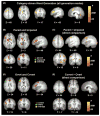Effects of generation mode in fMRI adaptations of semantic fluency: paced production and overt speech
- PMID: 17292926
- PMCID: PMC1894937
- DOI: 10.1016/j.neuropsychologia.2007.01.007
Effects of generation mode in fMRI adaptations of semantic fluency: paced production and overt speech
Abstract
Verbal fluency is a widely used neuropsychological paradigm. In fMRI implementations, conventional unpaced (self-paced) versions are suboptimal due to uncontrolled timing of responses, and overt responses carry the risk of motion artifact. We investigated the behavioral and neurofunctional effects of response pacing and overt speech in semantic category-driven word generation. Twelve right-handed adults (8 females), ages 21-37 were scanned in four conditions each: paced-overt, paced-covert, unpaced-overt, and unpaced-covert. There was no significant difference in the number of exemplars generated between overt versions of the paced and unpaced conditions. Imaging results for category-driven word generation overall showed left-hemispheric activation in inferior frontal cortex, premotor cortex, cingulate gyrus, thalamus, and basal ganglia. Direct comparison of generation modes revealed significantly greater activation for the paced compared to unpaced conditions in right superior temporal, bilateral middle frontal, and bilateral anterior cingulate cortex, including regions associated with sustained attention, motor planning, and response inhibition. Covert (compared to overt) conditions showed significantly greater effects in right parietal and anterior cingulate, as well as left middle temporal and superior frontal regions. We conclude that paced overt paradigms are useful adaptations of conventional semantic fluency in fMRI, given their superiority with regard to control over and monitoring of behavioral responses. However, response pacing is associated with additional non-linguistic effects related to response inhibition, motor preparation, and sustained attention.
Figures



References
-
- Barch DM, Sabb FW, Carter CS, Braver TS, Noll DC, Cohen JD. Overt verbal responding during fMRI scanning: Empirical investigations of problems and potential solutions. NeuroImage. 1999;10:642–657. - PubMed
-
- Birn RM, Cox RW, Bandettini PA. Experimental designs and processing strategies for fMRI studies involving overt verbal responses. Neuroimage. 2004;23(3):1046–1058. - PubMed
Publication types
MeSH terms
Substances
Grants and funding
LinkOut - more resources
Full Text Sources
Medical

